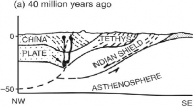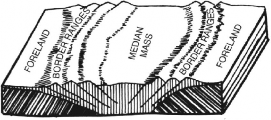(i) The Geosynclinal Origin
The main supporters of the geosynclinal origin of the Himalayas are Argand, Kober and Suess. According to these geologists, the disintegration of Pangaea, about 200 million years back, led to the formation of a long Tethys Sea between the Lauratian Shield (Angaraland) of the north and the Gondwanaland of the south. This sea was occupying the region of Himalayas during the Mesozoic Era (180 m years ago). At the end of the Palaeozoic and beginning of the Mesozoic Eras, the Tethys almost girdled the whole Earth running from Europe in the west to China in the east. Eroded material from the two land masses (Eurasian Shield—Angaraland and Gondwanaland) was deposited in the Tethys Sea and assumed considerable thickness due to the sinking nature of the sea bed (Fig. 2.4 and Fig. 2.5). During the Cretaceous Period, the bed of the sea started rising which led to the folding of three successive ranges of the Himalayas. The first upheaval led to the formation of the Greater Himalayas during the Eocene Period (about 65 in years back). Similarly, the second upheaval took place during the Miocene Period (about 45 million years back) resulting in the formation of the Lesser Himalayas, and the third upheaval started in the Pliocene period (about 1.4 million years back) resulting in the formation of the Shiwaliks or the Outer Himalayas.

(b) 15 million years ago (c) 15 million years to present

NW SE NW SE
K////I Indo-Gangetic Molasse Foredeep Tethyan Sediments
[•>!•'! Late Mesozoic Plutons Ophiolite Melange
[ Neogene Tourmailine Granite Metamorphic Foliation
HFF- Himalayan Frontal Fault
MBT-Main Boundary Thrust
Fig. 2.4 Origin of the Himalayas

After L.Kober, "Der Bau der Erde"2nd Ed., 1928.

